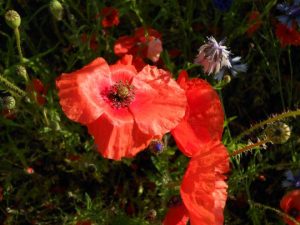Today marks the 100 year anniversary since this date in August 1914 when Britain entered what was to become the First World War. As a tribute to all those who fell during the war RBGE sowed a poppy field on the front lawn. We are pleased to see the red petals of the Corn Poppy, Papaver rhoeas, reflecting this sombre moment in time.
Preparation for this display started in 2013 with timed sowings of Poppy seed to gauge the optimum sow date to ensure flowering at the start of August, we are of course weather dependant as no two consecutive growing seasons will replicate climatic conditions. We also had to take into account the much shorter growing season resulting from a later sowing as traditionally Poppies in a cornfield would germinate the previous autumn or from late March with spring sown wheat, in this case an extra 7 or 8 weeks of growing, allowing them to flower above the sheaves of grain. Native to Eurasia and North Africa the poppy is associated with agriculture and probably spread with the transport and sale of seed crops. Loving sun, the crooked neck of the flower stem will straighten with the bud opening to flower for one day as the sun shines.
In early May we marked out the area, lifted the turf, rotovating and power harrowing to create a tilth. In mid-May we were joined by veterans from Poppy Scotland who helped sow the seed. The seeds are small, round and black in colour, about 10,000 per gram. They are long lived in the soil, germinating when soil is disturbed as in agriculture or more poignantly on battlefields.
This area of the garden was established during 1968 when the front range glasshouses were completed and the area of lawn to the south of these graded and seeded. As you would expect of an area that has been down to turf for almost five decades many seeds, in addition to the cornfield annual mix we sowed, germinated once the soil was disturbed through cultivation. The most prolific of these weed seeds to germinate being Shepherds Purse, Capsella bursa-pastoris, with its characteristic seed pods. Fast growing it rapidly exceeded the height of the Cornflowers and if not removed would, as it ripened, give a brown sheen to the area. In addition to exploding and adding to the seed bank in the soil.
We used a mixture of native cornfield annuals to complement the Poppy; Cornflower, Centaurea cyanus; Corn Marigold, Glebionis segetum; Mayweed, Triplospermum inodorum. This mixture extends the flowering season as Poppies flower for a couple of weeks at most. It also draws in pollinating insects and will later act as a host to seed eating birds.
In France the Cornflower or “Bluet” is used on Remembrance Day. The French soldiers of the First World War known as les bleuets from their grey/blue uniforms, the flower of the same name is used to remember them.
Many staff members from the Garden volunteered for service; some returning, some did not.
At the outbreak of war in August 1914, 110 staff worked at the Garden of whom one fifth were women. Of the men, 73 joined the Forces. Twenty men lost their lives, mostly in Flanders or Gallipoli.
The War Service Roll indicates that one RBGE staff member was killed in 1914; nine men fell in 1915, two in 1916, three in 1917 and five in 1918.
There are three interpretive plaques in the vicinity of the poppy field, one detailing what happened at RBGE during WW1; the story of the men who fought from the Garden especially David Hume who died three weeks into the start of the war; how Poppies became symbols of remembrance.
The Regius Keeper of the day, Sir Isaac Bayley Balfour, decided to commemorate some of the staff who lost their lives by naming plants in their honour.
Roscoea humeana for Private David Hume, killed 26th August 1914, Flanders.
Buddleja fallowiana for Sergeant George Fallow died 19th August 1915 from wounds received at Gallipoli.
Syringa adamiana for Private Thomas Adam, killed 16th May 1915 at Flanders.
Primula menziesiana for Private Alan Menzies, killed at Loos, 25th September 1915.
In addition there is a memorial tablet, unveiled in 1925, set on the wall in the Herbarium reception area as a lasting testimony to the members of staff who sacrificed their lives in the Great War.
In the library foyer the display cabinet holds an exhibition; “The Garden at War 1914 – 1918”. A wealth of information and artefacts collated by Leonie Paterson, the archives librarian.

